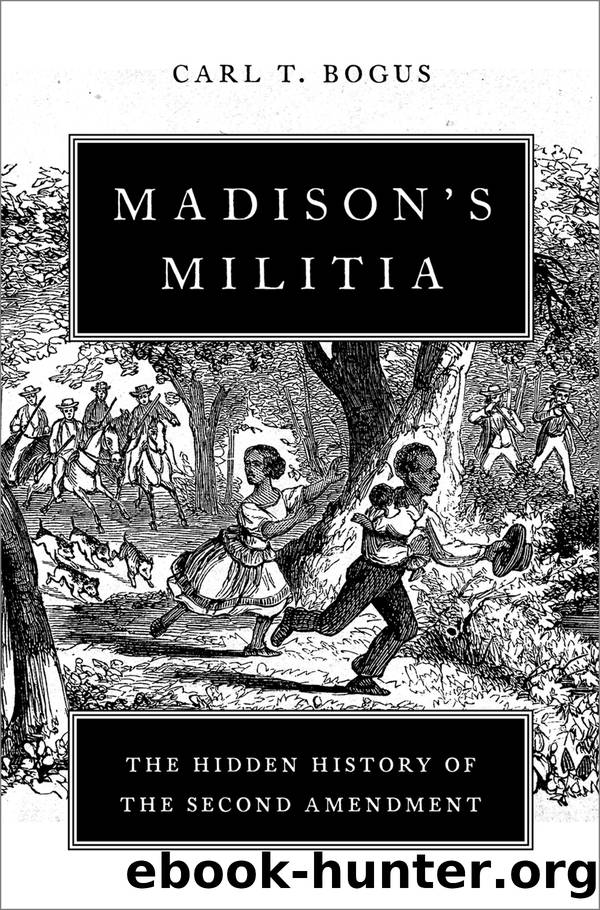Madison's Militia by Carl T. Bogus

Author:Carl T. Bogus
Language: eng
Format: epub
Publisher: Oxford University Press
Published: 2022-06-15T00:00:00+00:00
My thesis is that, in the main, Madison drafted the Second Amendment to ensure that Congress could not disarm the militia and thereby undermine the slave system in the South. If that is correct, why did four statesâthree of them Northern statesâadopt right-to-bear-arms provisions in their state constitutions?
The short answer to that question is this: All of those constitutions were adopted during the Revolutionary War. Glorifying the militia during the war was commonplaceâarguably, even necessary. The nation had not yet fully grasped how incapable the militia was at fighting professional soldiers.
Look at the dates on which those state bills of rights were adopted. The most important of the four provisions was that of Pennsylvania because the other three states largely copied its provision. Pennsylvania adopted its provision after Lexington, Concord, and Bunker Hill, but before any of the other battles we have discussed took place, including even the Battle of Long Island. Massachusetts, the last of the four states, adopted its provision before the Battles of Camden, Cowpens, and Guilford Courthouse. All four of these provisions were therefore adopted while Americans still held romanticized visions of citizen soldiers. Of course, the South then knew its militia were essential for slave controlâand considered that the most important duty of its militiaâbut while the war was still in progress few beyond the senior officer corps of the Continental Army had fully grasped that the militia were useful only for suppressing insurrections.
It is instructive, however, to take a brief look at special circumstances in these four states.
Pennsylvania. The first of these states, Pennsylvania, was not writing on a blank slate when it included a right-to-bear-arms provision in its constitution. It was undoubtedly inspired by a provision in the English Declaration of Rights of 1689 that we will take up in Chapter 9. That is where a so-called right to have arms originated. Surely, it was the war they were then fighting that motivated these four states to draw upon that history and include a right-to-bear-arms provision in their constitutions. But why did these four states adopt right-to-bear-arms provisions while most states did not? There is no single, self-evident explanation. There is nothing these four states had in common that sets them apart from the other eight states that did not do so.68 It is possible, however, that each of the four had something unique to itself that led it to adopt a right-to-bear-arms provision. While examining the history and culture of each of these four states in sufficient depth to find their distinguishing characteristics would entail a deeper dive than we can accomplish here, we can take a brief glimpse that might, at least, be suggestive.
Pennsylvania had a unique tradition against a government-regulated militia. Quakers controlled the state government and resisted supporting military organizations.69 Where others were quick to resolve territorial disputes with American Indians by force, Quakers preferred developing relationships with the Indians and negotiating with them. That left settlers in Pennsylvaniaâs western frontier feeling undefended in conflicts with the native inhabitants.
Download
This site does not store any files on its server. We only index and link to content provided by other sites. Please contact the content providers to delete copyright contents if any and email us, we'll remove relevant links or contents immediately.
Verus Israel: Study of the Relations Between Christians and Jews in the Roman Empire, AD 135-425 by Marcel Simon(568)
Phoenicians among Others: Why Migrants Mattered in the Ancient Mediterranean by Denise Demetriou(567)
Caesar Rules: The Emperor in the Changing Roman World (c. 50 BC â AD 565) by Olivier Hekster(550)
Europe, Strategy and Armed Forces by Sven Biscop Jo Coelmont(493)
Give Me Liberty, Seventh Edition by Foner Eric & DuVal Kathleen & McGirr Lisa(463)
Banned in the U.S.A. : A Reference Guide to Book Censorship in Schools and Public Libraries by Herbert N. Foerstel(461)
american english file 1 student book 3rd edition by Unknown(455)
Reading Colonial Japan by Mason Michele;Lee Helen;(452)
The Roman World 44 BC-AD 180 by Martin Goodman(450)
DS001-THE MAN OF BRONZE by J.R.A(436)
The Dangerous Life and Ideas of Diogenes the Cynic by Jean-Manuel Roubineau(427)
The Oxford History of World War II by Richard Overy(426)
Basic japanese A grammar and workbook by Unknown(426)
Introducing Christian Ethics by Samuel Wells and Ben Quash with Rebekah Eklund(425)
Imperial Rome AD 193 - 284 by Ando Clifford(424)
Literary Mathematics by Michael Gavin;(385)
Language Hacking Mandarin by Benny Lewis & Dr. Licheng Gu(365)
How to Reach the 9.0 in IELTS Academic Reading by IELTS Medical(349)
The Oxford History of the Renaissance by Campbell Gordon;(342)
